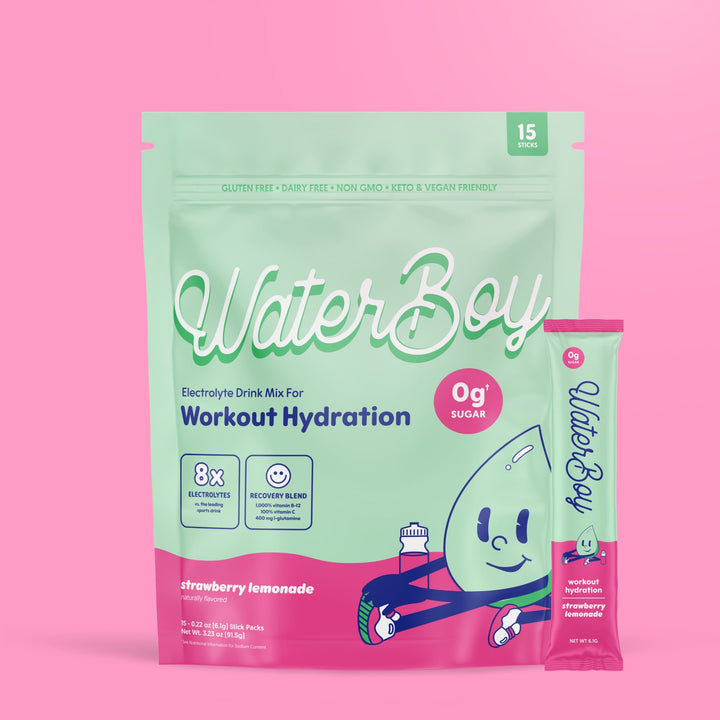TL;DR — Himalayan pink salt is ideal for hydration since it contains essential electrolytes such as potassium, magnesium, and calcium in addition to sodium chloride.
The electrolytes you absorb from salt are essential to regulate your fluid balance and stay hydrated. But some types of salt are built differently—literally. This leads to a common question: Can you sabotage your hydration efforts by using the “wrong” kind of salt?
Before we answer that, let’s take a step back to middle school biology class.
Salt is an essential nutrient called sodium chloride—or NaCl. Sodium and chloride are both electrolytes responsible for fluid balance, nerve function, muscle function, and nervous system function. That’s why you naturally crave salt.
Sports drinks and hangover supplements proudly proclaim their salt content. But many of them cut corners when it comes to quality. In this article, we’ll compare different types of salt so you can see for yourself which one to use when your fluid levels are on “E.”
What Is the Best Salt for Hydration?
The ideal salt for hydration is Himalayan pink salt since it contains minerals like potassium, magnesium, and calcium in addition to sodium chloride—all of which are electrolytes that need to be replenished when you sweat (or when you’re hungover).
Harvested from ancient sea salt deposits in the Himalayan mountains, it gets its distinctive pink color from the high concentration of minerals.
Let’s break down 4 reasons why Himalayan pink salt is the G.O.A.T. for getting you rehydrated.
1. Rich Electrolyte Content
Unlike refined table salt, which is stripped of most minerals during processing, Himalayan pink salt contains trace minerals, including potassium, magnesium, calcium, and iron. These minerals are essential electrolytes that play a vital role in maintaining fluid balance, nerve function, and muscle contraction, making Himalayan pink salt a more holistic option for hydration.
2. Minimal Processing
Himalayan pink salt is minimally processed and free from additives and anti-caking agents often found in refined table salt. Its natural state ensures that the salt retains its original mineral composition and purity, preserving its health benefits.
3. Hygroscopic Properties
Himalayan pink salt has hygroscopic properties, meaning it attracts and retains moisture from the surrounding environment. When consumed, this hygroscopic nature of the salt enhances water absorption in the body. It also facilitates the retention of water within cells, ensuring efficient hydration and minimizing fluid loss.
4. Better Taste
Most people find that Himalayan pink salt has a milder taste compared to table salt, making it more palatable. When you’re drenched with sweat after a workout or suffering the aftermath of tequila shots, the last thing you’ll crave is harsh table salt. That’s why WaterBoy uses Himalayan pink salt to make our Weekend Recovery and Athletic Recovery formulas as enjoyable as they are effective.
Workout Hydration

$24.99
WorkoutRather than make a one-size-fits-all-dehydration product with varying amounts of sugar and salt, we make our formulas specifically when you need them. Our workout hydration formula is not only packed in electrolytes, but we've added a blend of ingredients to… read more
2 Other Types of Salt for Hydration
If you look at the ingredient lists on popular hydration supplements, you’ll notice the two most popular types of salt are sea salt and plain old table salt. Let’s unpack what’s in there and how they stack up to pink Himalayan salt.
Table Salt
Regular table salt is abundant and dirt cheap, but there are some big tradeoffs. For starters, table salt is refined with chemicals like chlorine and sulfuric acid that strip away its natural minerals. As a result, you’re left with just sodium chloride and far fewer electrolytes, such as potassium and magnesium.
Additionally, table salt often contains anti-caking agents to prevent it from clumping up during transportation and storage. Many anti-caking agents contain aluminum, a neurotoxin that’s been linked to Alzheimer’s disease.
Sea Salt
Sea salt is harvested from evaporated seawater and contains minerals including sodium, potassium, and magnesium. This makes it a good option for replenishing electrolytes. However, sea salt has a big problem: microplastics.
Ocean waters are overflowing with tiny plastic particles, which have been linked to all sorts of health issues. One 2018 study detected microplastics in 25 different brands of sea salt from all over the world.
Micronutrients? Hell yeah. Microplastics? Hard pass.
Don’t Settle When It Comes to Salt
As you can see, salt is far more than something you sprinkle on your food to make it taste good. It’s an essential nutrient that’s jam-packed with electrolytes to keep you hydrated—but only if you choose the right kind.
Comparing the table salt in Gatorade to the pink Himalayan salt in WaterBoy is like comparing white bread to whole-grain bread. One is loaded with nutrients you need; the other is a shadow of its former self, stripped away of all the good stuff.
WaterBoy’s Weekend Recovery formula has up to four times the amount of electrolytes than other hydration supplements which shall not be named. That’s not a coincidence…it’s because we know the best salt delivers the best results.
Workout Hydration

$24.99
WorkoutRather than make a one-size-fits-all-dehydration product with varying amounts of sugar and salt, we make our formulas specifically when you need them. Our workout hydration formula is not only packed in electrolytes, but we've added a blend of ingredients to… read more




